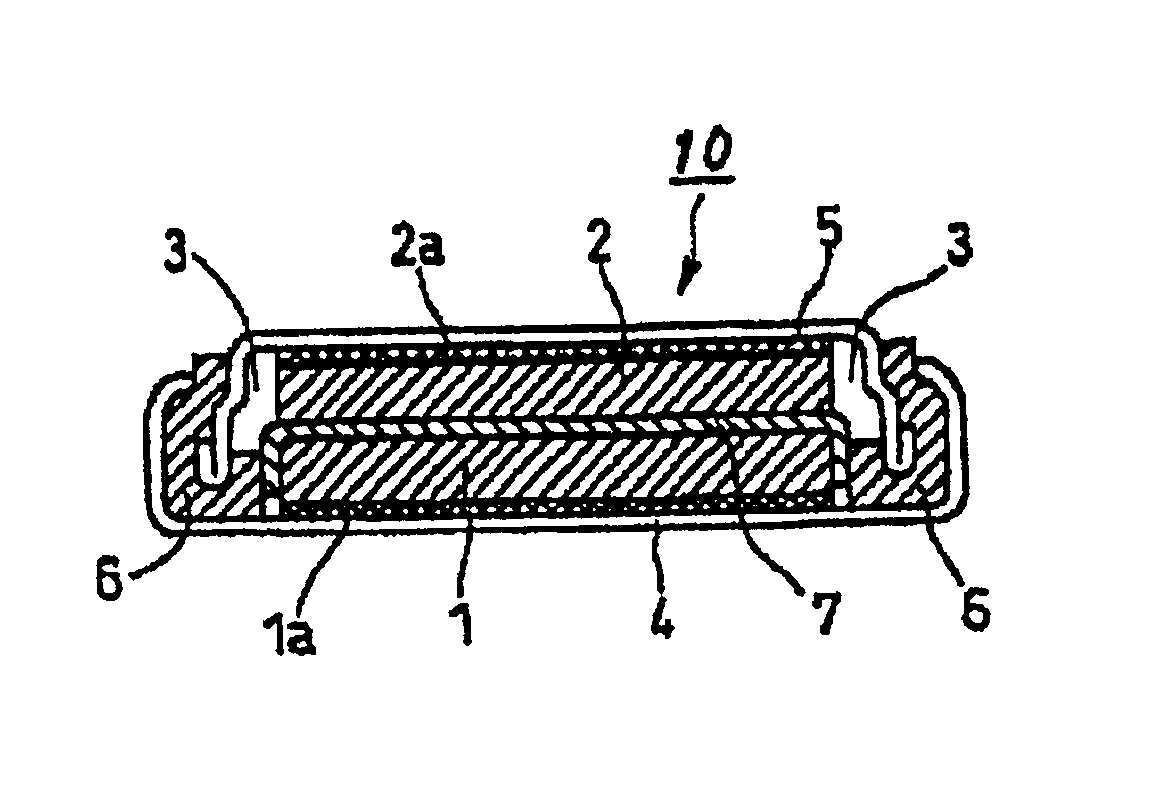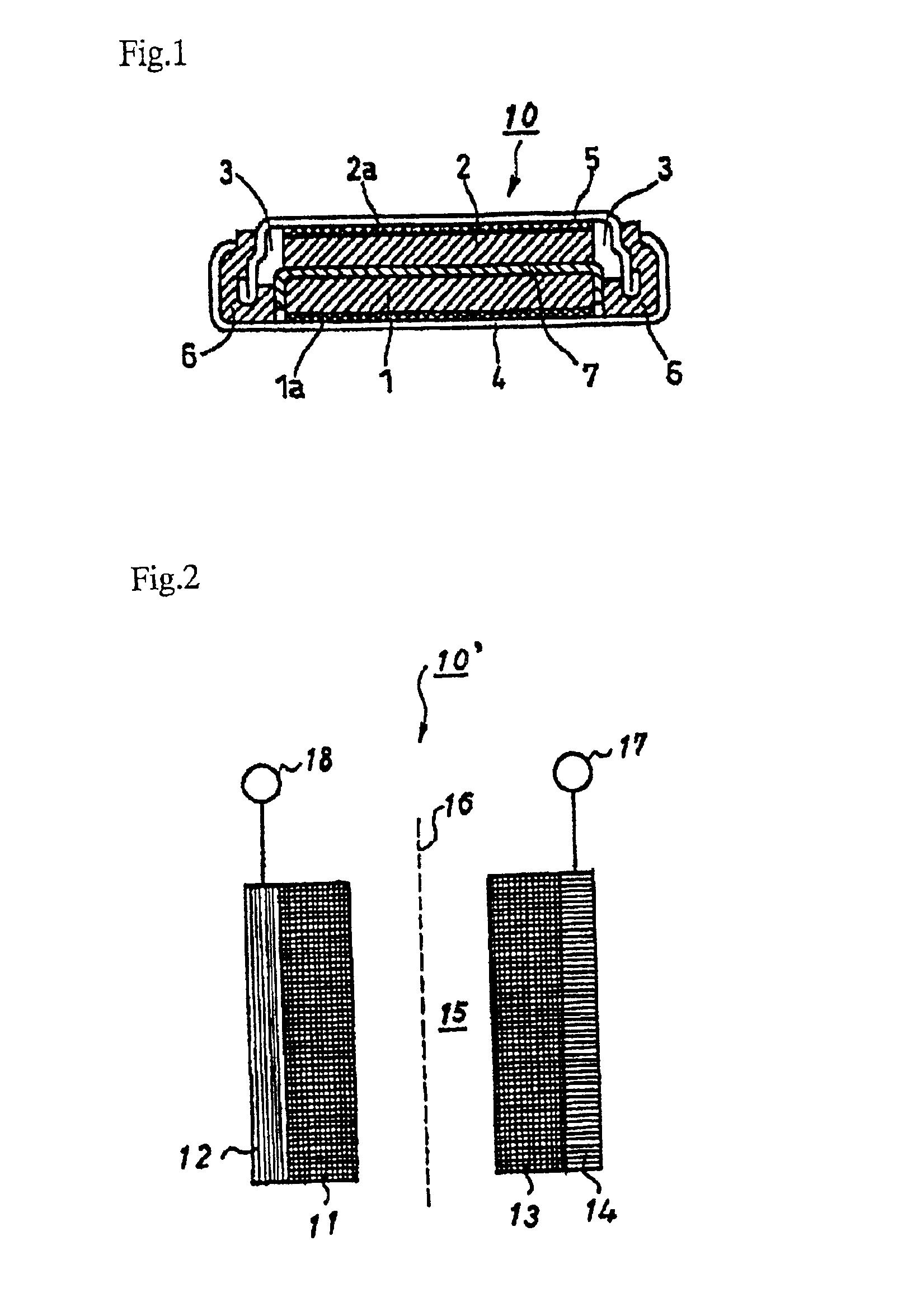Nonaqueous electrolytic solution and nonaqueous secondary battery
a non-aqueous, secondary battery technology, applied in the direction of non-aqueous electrolyte cells, germanium organic compounds, electrochemical generators, etc., can solve the problems of reducing the capacity and internal resistance of the non-aqueous secondary battery, the electrolytic solution proposed, and the insufficient electrical characteristics of the electrolytic solution, etc., to achieve excellent cycle characteristics, reduce the rate of capacity or internal resistance, and improve the effect of internal resistance in low temperatur
- Summary
- Abstract
- Description
- Claims
- Application Information
AI Technical Summary
Benefits of technology
Problems solved by technology
Method used
Image
Examples
example 2
LiPF6 was dissolved in a mixed organic solvent of 30 vol % of ethylene carbonate and 70 vol % of diethyl carbonate in a concentration of 1 mol / l, and a test compound shown in Table 2 below was added thereto in the amount shown in Table 2 to prepare a nonaqueous electrolytic solution.
Lithium secondary batteries were fabricated in the same manner as in Example 1. Low-temperature characteristics of the batteries were measured as follows. The results obtained are shown in Table 2. The initial battery capacity of the battery of Comparative Example 2-1 containing no test compound being taken as a standard, all the other batteries were equal or superior to the battery of Comparative Example 2-1 in initial battery capacity.
Measurement of Low-temperature Characteristics:
The discharge capacity and the internal resistance at −30° C. were measured in the same manner as in Example 1 and compared with those of Comparative Example 2-1 containing no test compound.
Discharge capacity ratio (%)=(disc...
example 3
LiPF6 was dissolved in a mixed organic solvent of 30 vol % of ethylene carbonate, 60 vol % of diethyl carbonate and 10 vol % of triethyl phosphate in a concentration of 1 mol / l, and a test compound shown in Table 3 below was added thereto in an amount of 0.5 vol % to prepare a nonaqueous electrolytic solution.
Lithium secondary batteries were fabricated in the same manner as in Example 1. The discharge capacity retention (%) after 500 cycles and the internal resistance increase (%) after 500 cycles were measured in the same manner as in the high-temperature cycle characteristics test and the internal resistance increase measurement in Example 1. In addition, a flame retardance test was carried out in accordance with the following method. The results obtained are shown in Table 3.
Flame Retardance Test:
A strip of manila paper for a separator 15 mm wide, 320 mm long and 0.04 mm thick was dipped in the electrolytic solution shown in Table 3 and then hung vertically for 3 minutes to drip ...
example 4
LiPF6 was dissolved in a mixed organic solvent of 30vol % of ethylene carbonate, 60 vol % of diethyl carbonate and 10 vol % of triethyl phosphate in a concentration of 1 mol / l, and a test compound shown in Table 4 below was added thereto in an amount of 0.5 wt % to prepare a nonaqueous electrolytic solution.
Lithium secondary batteries were fabricated in the same manner as in Example 1. The low-temperature characteristics in terms of discharge capacity ratio (%) and internal resistance ratio (%) were measured in the same manner as in Example 2. In addition, a flame retardance test was carried out in the same manner as in Example 3. The results obtained are shown in Table 4.
TABLE 4Low-TemperatureCharacteristics (−30° C.)DischargeInternalCapacity RatioResistanceFlameTest Compound(%)Ratio (%)RetardanceEx. 4-1dibutyltin (1-allyloxymethyl)ethylene14271goodglycolateEx. 4-2monooctyltin trimethoxide13674goodEx. 4-3dibutyltin dipropoxide13575goodEx. 4-4dibutyltin (1-hexyl)ethylene13872goodgly...
PUM
| Property | Measurement | Unit |
|---|---|---|
| volume | aaaaa | aaaaa |
| weight | aaaaa | aaaaa |
| temperature | aaaaa | aaaaa |
Abstract
Description
Claims
Application Information
 Login to View More
Login to View More - R&D
- Intellectual Property
- Life Sciences
- Materials
- Tech Scout
- Unparalleled Data Quality
- Higher Quality Content
- 60% Fewer Hallucinations
Browse by: Latest US Patents, China's latest patents, Technical Efficacy Thesaurus, Application Domain, Technology Topic, Popular Technical Reports.
© 2025 PatSnap. All rights reserved.Legal|Privacy policy|Modern Slavery Act Transparency Statement|Sitemap|About US| Contact US: help@patsnap.com



